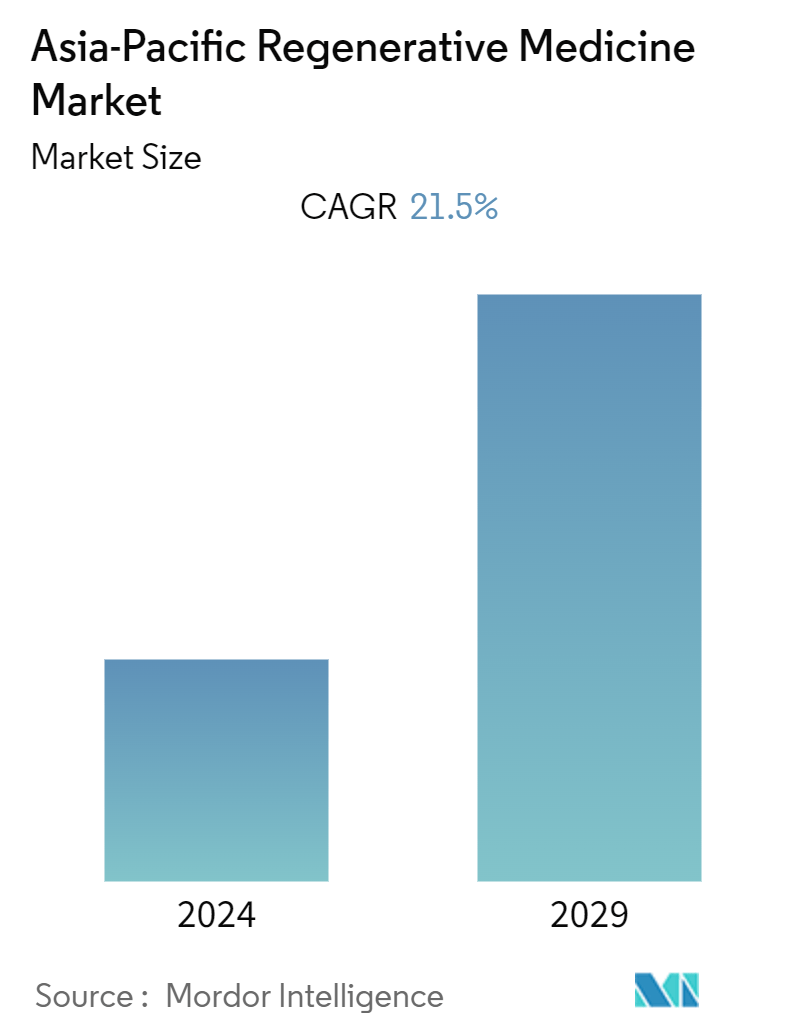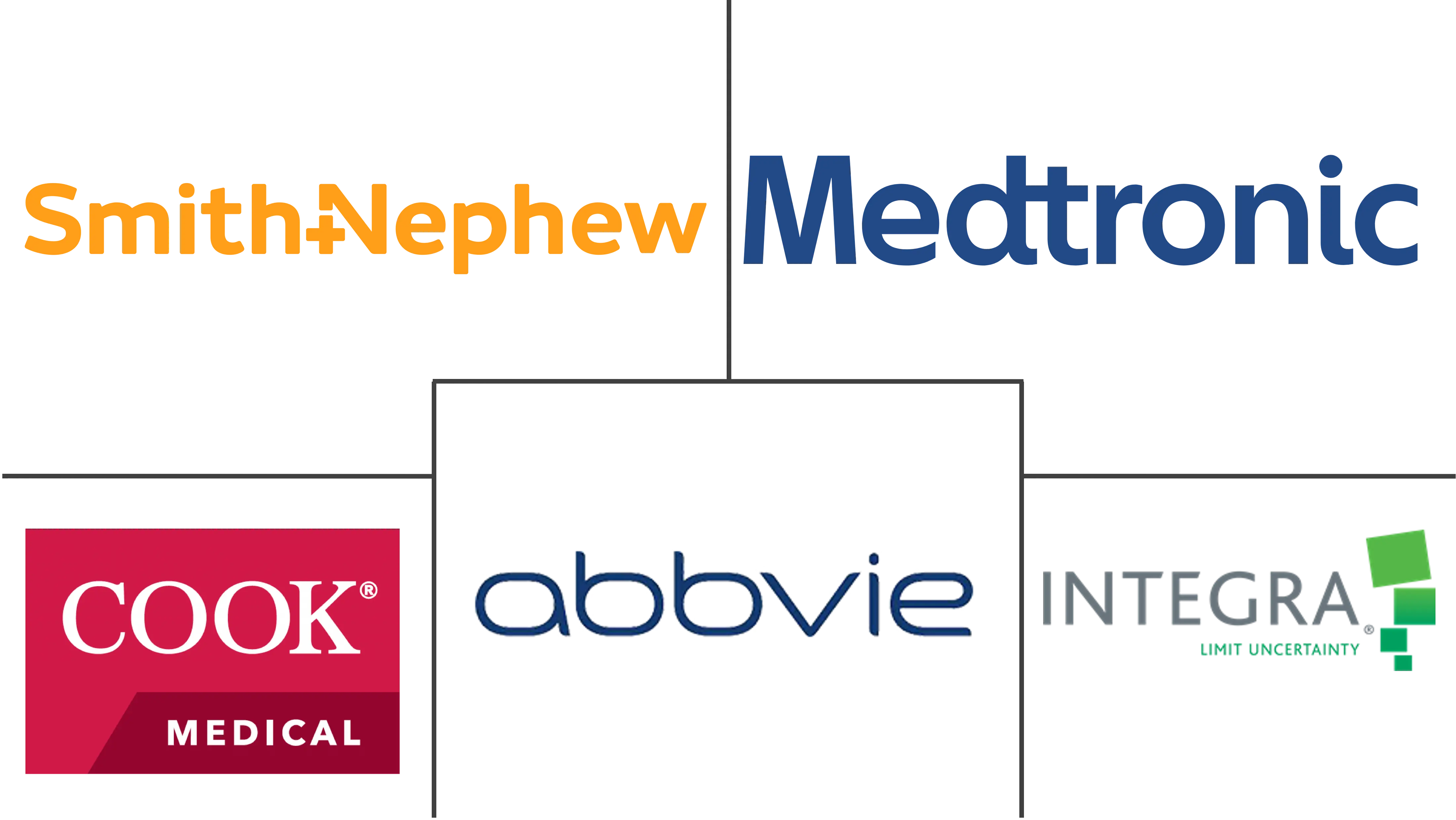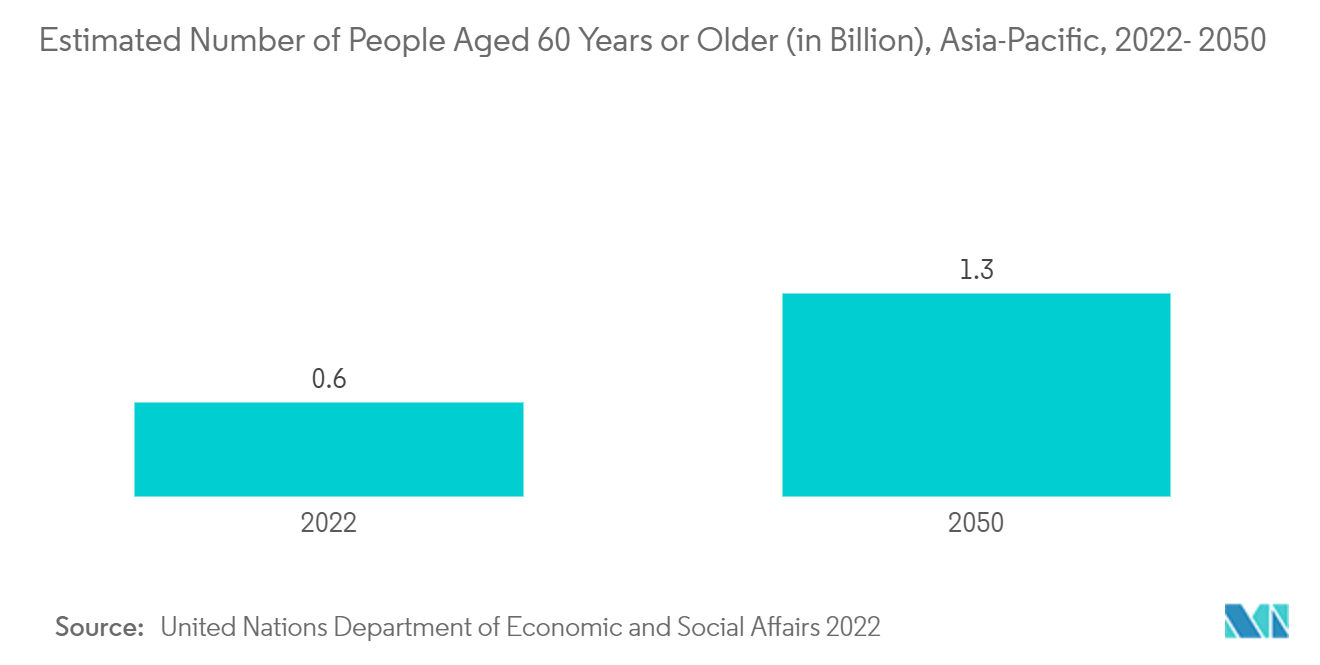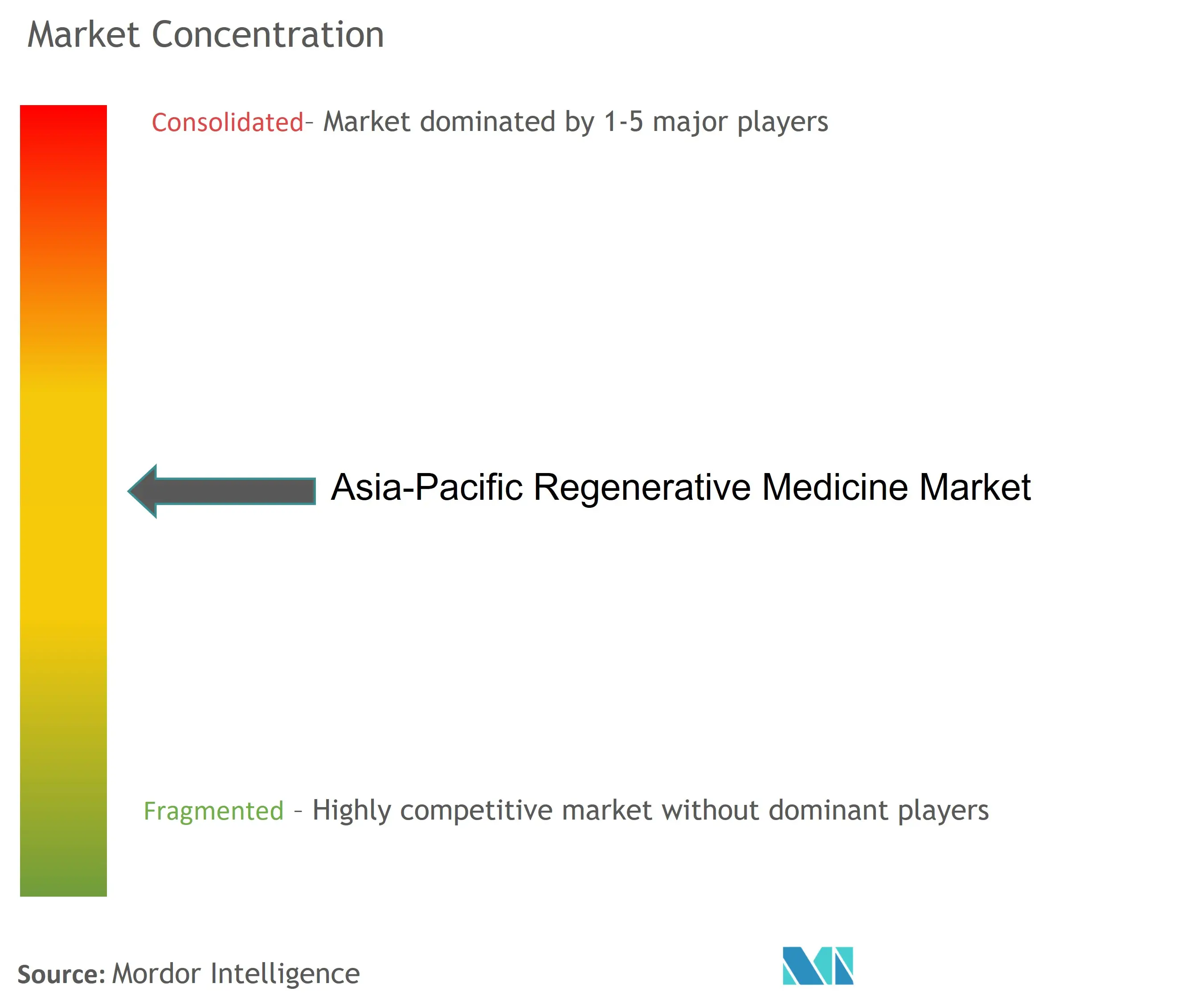Asia Pacific Regenerative Medicine Market Size

| Study Period | 2021 - 2029 |
| Base Year For Estimation | 2023 |
| Forecast Data Period | 2024 - 2029 |
| Historical Data Period | 2021 - 2022 |
| CAGR (2024 - 2029) | 21.50 % |
Major Players
*Disclaimer: Major Players sorted in no particular order |
Asia Pacific Regenerative Medicine Market Analysis
The Asia-Pacific Regenerative Medicine Market is expected to register a CAGR of 21.5% during the forecast period.
COVID-19 had a significant impact on the regenerative medicine market across the Asia-Pacific region during the pandemic period. The usage of regenerative medicine in treating COVID-19 diseases and its approvals by regulatory authorities had a crucial impact on the market's growth. For instance, in September 2021, the Central Drugs Standard Control Organization of the Government of India (CDSCO) approved a stem cell-based therapy trial for COVID-19 pneumonia treatment. The clinical trial was conducted in two phases to evaluate the safety and efficacy of Mesocel for treating patients with moderate to severe COVID-19. Such approvals indicated that Asian countries adopted regenerative medicine as a treatment measure for COVID-19, ultimately crucially impacting the market during the pandemic period. In addition, the demand for regenerative medicine is expected to remain intact during the post-pandemic period due to the rising focus on treating various chronic diseases, thereby contributing to the market's growth.
The key factors propelling the growth of the Asia-Pacific regenerative medicine market are the increased funding for regenerative medicine and increasing research and development activities for the development of regenerative medicine. Additionally, the increasing adoption of regenerative medicine for treating various chronic disorders is expected to boost the market's growth over the forecast period. For instance, in February 2022, the Government of India invested over Rs. 8.13 crore (approximately USD 1 million) to support state-of-the-art stem cell research facilities in 40 health research and educational institutions. Further, the report published by the Australian Government in October 2021 stated that the Australian Government is boosting Australian-led stem cell research through USD 25 million in grants. These funds are availed from the Medical Research Future Fund (MRFF). Such government funding in Asia-Pacific is expected to contribute to the market's growth.
Also, in October 2022, Maruti Hospital in Tiruchi, India, introduced a proprietary stem cell treatment for osteoarthritis patients to reduce their dependence on painkillers and provide a more long-lasting solution to knee joint pain. Such increasing adoption of regenerative medicine in treating various disorders is expected to contribute to the market's growth over the forecast period.
However, the high cost of treatments is expected to restrain the market's growth over the forecast period.
Asia Pacific Regenerative Medicine Market Trends
Cardiovascular is Expected to Show Significant Growth in the Market Over the Forecast Period
Cardiac regeneration is a broad effort to repair irreversibly damaged heart tissue with cutting-edge, including stem cell and cell-free therapy. The factors such as the increasing prevalence of cardiovascular diseases, the rising geriatric population, and the rising focus on developing regenerative medicine for the treatment of cardiac disorders are expected to drive the growth of the studied segment.
For instance, the NCBI article published in January 2021 mentioned that of the 290 million people who suffer from cardiovascular disease patients in China, 13 million had a stroke, 11 million had coronary heart disease, 4 million had coronary heart disease, 4.5 million had pulmonary heart disease, 2.5 million pulmonary heart disease, 2 million had heart failure and others in 2021. Additionally, the data published by WPR in 2022 shows that one in every five adults in China had some cardiovascular disease in 2022. the report also mentioned a 50% increase in cardiovascular disease by 2030. Additionally, the data published by ESCAP in July 2022 mentioned that the Asia-Pacific population aged 60 years or over was 630 million in 2022, representing 60% of the world's older population. Thus, the rising prevalence of cardiovascular diseases and the increasing geriatric population prone to develop cardiac disorders are expected to drive the demand for regenerative medicine, propelling the segment growth.
Additionally, the increasing investments by governments in Asia-Pacific for the research and development of regenerative medicine in the treatment of cardiac disorders are also expected to contribute to market growth. For instance, in June 2021, the Australian Government invested USD 180 million to improve the research and development of stem cell therapies. From this fund, the Murdoch Children's Institute in Australia received almost USD 1 million to evaluate the potential of bioengineered heart tissue for children's congenital heart repair.
Thus, the increasing prevalence of cardiac disorders, the rising geriatric population, and increasing funding from the government are expected to boost the growth of the studied segment.

Japan is Expected to Hold Significant Share of the Regenerative Medicine Market Over the Forecast Period
Japan is expected to hold a notable share of the market owing to the increasing research and developments for regenerative medicine. Technological advancements in healthcare and the presence of key market players in Japan are also expected to play a crucial role in the market growth in this country.
For instance, in December 2021, Hiroshima University started human trials for a treatment that offers the potential to reverse paralysis and language disorders after moderate to severe stroke using therapeutically superior mesenchymal stem cells derived from the cranial bone. The study period for the clinical trial is until December 2023. Such increasing research and developments of regenerative medicine in Japan are expected to drive the growth of the market. Additionally, the data published by AMED in April 2021, mentioned that Japan Regenerative Medicine Project offers around YEN 15-25 million (USD 11 - 19 thousand) per year and also encourages collaboration with researchers in other countries for the development of advanced regenerative medicine. Thus, the increasing funding from the government for the development of advanced regenerative medicine is also expected to drive the growth of the market in this country.
Additionally, the rising prevalence of chronic disorders among the Japanese population is also expected to drive the demand for advanced regenerative medicines, thereby contributing to the growth of the market. For instance, the BMC article published in October 2021, mentioned that by 2046, the prevalence of dementia in people older than 65 years is projected to exceed 25% in Japan. Thus, the increasing prevalence of chronic disorders is expected to rise the demand for effective and advanced therapies such as regenerative medicine, thereby fueling the growth of the market.

Asia Pacific Regenerative Medicine Industry Overview
The Asia-Pacific regenerative medicine market is moderately fragmented and competitive. The major players are Abbvie (Allergan plc), Baxter International Inc., Becton, Dickinson and Company, Cook Group Incorporated, Integra LifeSciences Corporation, Medtronic PLC, Merck KGaA, Smith & Nephew plc, Thermo Fisher Scientific.
Asia Pacific Regenerative Medicine Market Leaders
-
Cook Group Incorporated
-
Integra LifeSciences Corporation
-
Medtronic PLC
-
Smith & Nephew plc (Osiris Therapeutics)
-
AbbVie (Allergan plc)
*Disclaimer: Major Players sorted in no particular order

Asia Pacific Regenerative Medicine Market News
- November 2022: Metcella Inc. was selected by Japan Agency for Medical Research and development and received up to USD 7 million for promoting the development of regenerative medicine products using cardiac stem cells.
- September 2022: Alkem Laboratories announced that its off-the-shelf cell therapy product, StemOne, had received regulatory approval from the Drug Controller General of India (DCGI) for its launch in India.
Asia Pacific Regenerative Medicine Market Report - Table of Contents
1. INTRODUCTION
1.1 Study Assumptions and Market Definition
1.2 Scope of the Study
2. RESEARCH METHODOLOGY
3. EXECUTIVE SUMMARY
4. MARKET DYNAMICS
4.1 Market Overview
4.2 Market Drivers
4.2.1 Technological Advancements in Regenerative Medicine
4.2.2 Increasing Adoption of Stem Cell Technology
4.2.3 Rising Government Initiatives
4.3 Market Restraints
4.3.1 High Cost of Treatments
4.4 Porter's Five Forces Analysis
4.4.1 Threat of New Entrants
4.4.2 Bargaining Power of Buyers/Consumers
4.4.3 Bargaining Power of Suppliers
4.4.4 Threat of Substitute Products
4.4.5 Intensity of Competitive Rivalry
5. MARKET SEGMENTATION (Market Size - Value in USD million)
5.1 By Type of Technology
5.1.1 Stem Cell Therapy
5.1.2 Biomaterial
5.1.3 Tissue Engineering
5.1.4 Other Types of Technologies
5.2 By Application
5.2.1 Bone Graft Substitutes
5.2.2 Osteoarticular Diseases
5.2.3 Dermatology
5.2.4 Cardiovascular
5.2.5 Central Nervous System
5.2.6 Other Applications
5.3 Geography
5.3.1 China
5.3.2 Japan
5.3.3 India
5.3.4 Australia
5.3.5 South Korea
5.3.6 Rest of Asia-Pacific
6. COMPETITIVE LANDSCAPE
6.1 Company Profiles
6.1.1 AbbVie (Allergan plc)
6.1.2 Baxter International Inc.
6.1.3 Becton, Dickinson and Company
6.1.4 Cook Group Incorporated
6.1.5 Integra LifeSciences Corporation
6.1.6 Medtronic PLC
6.1.7 Merck KGaA
6.1.8 Smith & Nephew plc (Osiris Therapeutics)
6.1.9 Thermo Fisher Scientific
6.1.10 MetCella Inc
6.1.11 Orthocell Ltd
6.1.12 Shenzhen SiBono Genetech Co., Ltd
6.1.13 Tegoscience
- *List Not Exhaustive
7. MARKET OPPORTUNITIES AND FUTURE TRENDS
Asia Pacific Regenerative Medicine Industry Segmentation
As per the scope of the report, regenerative medicines are used to repair, r eplace, and regenerate the tissues and organs affected by injury, disease, or the natural aging process. These medicines restore the functionality of cells and tissues and are used in several degenerative disorders, such as dermatology, neurodegenerative diseases, cardiovascular, and orthopedic applications. The Asia-Pacific Regenerative Medicine Market is segmented by Type of Technology (Stem Cell Therapy, Biomaterial, Tissue Engineering, Other Types of Technologies), Application (Bone Graft Substitutes, Osteoarticular Diseases, Dermatology, Cardiovascular, Central Nervous System, and Other Applications), and Geography (China, Japan, India, Australia, South Korea, Rest of Asia-Pacific). The report offers the value (in USD million) for the above segments.
| By Type of Technology | |
| Stem Cell Therapy | |
| Biomaterial | |
| Tissue Engineering | |
| Other Types of Technologies |
| By Application | |
| Bone Graft Substitutes | |
| Osteoarticular Diseases | |
| Dermatology | |
| Cardiovascular | |
| Central Nervous System | |
| Other Applications |
| Geography | |
| China | |
| Japan | |
| India | |
| Australia | |
| South Korea | |
| Rest of Asia-Pacific |
Asia Pacific Regenerative Medicine Market Research FAQs
What is the current Asia-Pacific Regenerative Medicine Market size?
The Asia-Pacific Regenerative Medicine Market is projected to register a CAGR of 21.5% during the forecast period (2024-2029)
Who are the key players in Asia-Pacific Regenerative Medicine Market?
Cook Group Incorporated, Integra LifeSciences Corporation, Medtronic PLC, Smith & Nephew plc (Osiris Therapeutics) and AbbVie (Allergan plc) are the major companies operating in the Asia-Pacific Regenerative Medicine Market.
What years does this Asia-Pacific Regenerative Medicine Market cover?
The report covers the Asia-Pacific Regenerative Medicine Market historical market size for years: 2021, 2022 and 2023. The report also forecasts the Asia-Pacific Regenerative Medicine Market size for years: 2024, 2025, 2026, 2027, 2028 and 2029.
Asia Pacific Regenerative Medicine Industry Report
Statistics for the 2023 Asia Pacific Regenerative Medicine market share, size and revenue growth rate, created by Mordor Intelligence™ Industry Reports. Asia Pacific Regenerative Medicine analysis includes a market forecast outlook to 2029 and historical overview. Get a sample of this industry analysis as a free report PDF download.



